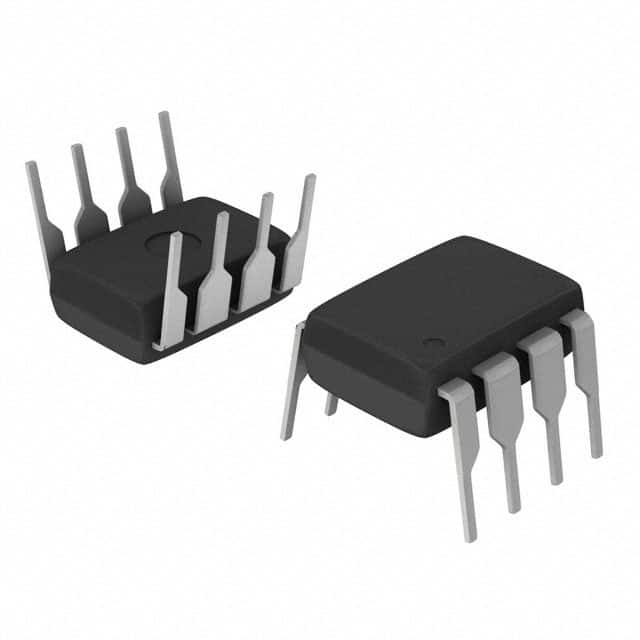Xem thông số kỹ thuật để biết chi tiết sản phẩm.

LM393N
Product Overview
Category: Integrated Circuit (IC)
Use: LM393N is a dual differential comparator integrated circuit. It is commonly used in electronic circuits for comparing voltages and determining the difference between two input signals.
Characteristics: - Dual differential comparator - Low power consumption - Wide supply voltage range - High input impedance - Open collector output - Fast response time
Package: LM393N is available in an 8-pin DIP (Dual Inline Package) or SOIC (Small Outline Integrated Circuit) package.
Essence: The essence of LM393N lies in its ability to compare two input voltages and provide a digital output based on the comparison result.
Packaging/Quantity: LM393N is typically sold in reels or tubes containing multiple units, with each reel/tube containing a specific quantity of ICs.
Specifications
LM393N has the following specifications:
- Supply Voltage Range: 2V to 36V
- Input Voltage Range: -0.3V to Vcc + 0.3V
- Output Current: 6mA
- Response Time: 1.3μs
- Operating Temperature Range: -40°C to 85°C
Pin Configuration
The pin configuration of LM393N is as follows:
____
IN- |1 8| Vcc
IN+ |2 7| OUT
GND |3 6| OUT
IN+ |4 5| IN-
----
Functional Features
- Dual Comparator: LM393N consists of two independent comparators, allowing simultaneous comparison of two different input signals.
- Open Collector Output: The outputs of the comparators are open collector, which means they can be connected to external devices for various applications.
- Wide Supply Voltage Range: LM393N can operate within a wide range of supply voltages, making it suitable for different electronic systems.
- Fast Response Time: The comparator has a fast response time of 1.3μs, enabling quick comparison and decision-making in circuits.
Advantages and Disadvantages
Advantages: - Low power consumption - High input impedance - Wide supply voltage range - Fast response time
Disadvantages: - Lack of built-in hysteresis - Limited output current capacity
Working Principles
LM393N works based on the principle of comparing two input voltages. It compares the voltage at the IN+ pin with the voltage at the IN- pin and provides a digital output based on the result of this comparison. If the voltage at IN+ is higher than the voltage at IN-, the output goes low (0V), and if the voltage at IN+ is lower, the output goes high (Vcc).
Detailed Application Field Plans
LM393N finds applications in various fields, including:
- Voltage Monitoring: It can be used to monitor battery voltage levels and trigger alarms or actions when the voltage falls below a certain threshold.
- Level Sensing: LM393N can be employed to detect liquid levels in tanks or containers by comparing the voltage from a sensor with a reference voltage.
- Speed Control: It can be utilized in motor control circuits to compare the speed of a rotating object with a set reference speed and adjust accordingly.
- Light Sensing: LM393N can be used in light-sensitive circuits to compare the intensity of light falling on two sensors and trigger actions based on the comparison result.
Detailed and Complete Alternative Models
Some alternative models to LM393N include:
- LM339: Quad differential comparator
- LM311: Single differential comparator with open collector output
- LM324: Quad operational amplifier with built-in comparators
These alternative models offer similar functionality to LM393N but may have different specifications and pin configurations.
Word count: 554 words
Liệt kê 10 câu hỏi và câu trả lời thường gặp liên quan đến ứng dụng LM393N trong giải pháp kỹ thuật
Sure! Here are 10 common questions and answers related to the application of LM393N in technical solutions:
Q: What is LM393N? A: LM393N is a dual differential comparator IC (integrated circuit) commonly used in electronic circuits for comparing voltages.
Q: What are the typical applications of LM393N? A: LM393N is widely used in various applications such as voltage level detection, motor speed control, light sensing, proximity sensing, and temperature monitoring.
Q: How does LM393N work? A: LM393N compares two input voltages and provides a digital output based on the comparison result. It has an open-drain output that can be easily interfaced with microcontrollers or other digital logic circuits.
Q: What is the operating voltage range of LM393N? A: The operating voltage range of LM393N typically varies from 2V to 36V, making it suitable for both low and high voltage applications.
Q: Can LM393N handle AC signals? A: No, LM393N is designed to work with DC signals only. It cannot handle AC signals directly.
Q: How do I connect LM393N in my circuit? A: LM393N requires two input voltages (V+ and V-) and provides a digital output (OUT). Connect the positive input voltage to V+, the negative input voltage to V-, and the output to your desired circuitry.
Q: What is the output voltage range of LM393N? A: The output voltage range of LM393N depends on the supply voltage used. It typically ranges from ground (0V) to the supply voltage minus a small voltage drop.
Q: Can LM393N drive a load directly? A: No, LM393N has an open-drain output that requires an external pull-up resistor to drive a load. The value of the pull-up resistor depends on the load requirements.
Q: Can I use LM393N in automotive applications? A: Yes, LM393N is suitable for automotive applications as it can handle the wide voltage range typically found in automotive systems.
Q: Are there any precautions to consider when using LM393N? A: Yes, some precautions include providing proper decoupling capacitors near the power supply pins, avoiding excessive input voltage or current, and ensuring proper grounding to minimize noise interference.
Please note that these answers are general and may vary depending on specific circuit designs and requirements.

